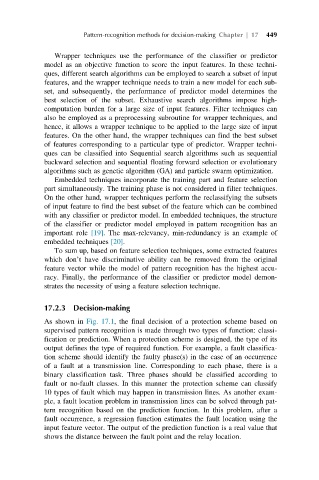Page 489 - Decision Making Applications in Modern Power Systems
P. 489
Pattern-recognition methods for decision-making Chapter | 17 449
Wrapper techniques use the performance of the classifier or predictor
model as an objective function to score the input features. In these techni-
ques, different search algorithms can be employed to search a subset of input
features, and the wrapper technique needs to train a new model for each sub-
set, and subsequently, the performance of predictor model determines the
best selection of the subset. Exhaustive search algorithms impose high-
computation burden for a large size of input features. Filter techniques can
also be employed as a preprocessing subroutine for wrapper techniques, and
hence, it allows a wrapper technique to be applied to the large size of input
features. On the other hand, the wrapper techniques can find the best subset
of features corresponding to a particular type of predictor. Wrapper techni-
ques can be classified into Sequential search algorithms such as sequential
backward selection and sequential floating forward selection or evolutionary
algorithms such as genetic algorithm (GA) and particle swarm optimization.
Embedded techniques incorporate the training part and feature selection
part simultaneously. The training phase is not considered in filter techniques.
On the other hand, wrapper techniques perform the reclassifying the subsets
of input feature to find the best subset of the feature which can be combined
with any classifier or predictor model. In embedded techniques, the structure
of the classifier or predictor model employed in pattern recognition has an
important role [19]. The max-relevancy, min-redundancy is an example of
embedded techniques [20].
To sum up, based on feature selection techniques, some extracted features
which don’t have discriminative ability can be removed from the original
feature vector while the model of pattern recognition has the highest accu-
racy. Finally, the performance of the classifier or predictor model demon-
strates the necessity of using a feature selection technique.
17.2.3 Decision-making
As shown in Fig. 17.1, the final decision of a protection scheme based on
supervised pattern recognition is made through two types of function: classi-
fication or prediction. When a protection scheme is designed, the type of its
output defines the type of required function. For example, a fault classifica-
tion scheme should identify the faulty phase(s) in the case of an occurrence
of a fault at a transmission line. Corresponding to each phase, there is a
binary classification task. Three phases should be classified according to
fault or no-fault classes. In this manner the protection scheme can classify
10 types of fault which may happen in transmission lines. As another exam-
ple, a fault location problem in transmission lines can be solved through pat-
tern recognition based on the prediction function. In this problem, after a
fault occurrence, a regression function estimates the fault location using the
input feature vector. The output of the prediction function is a real value that
shows the distance between the fault point and the relay location.

